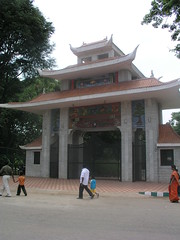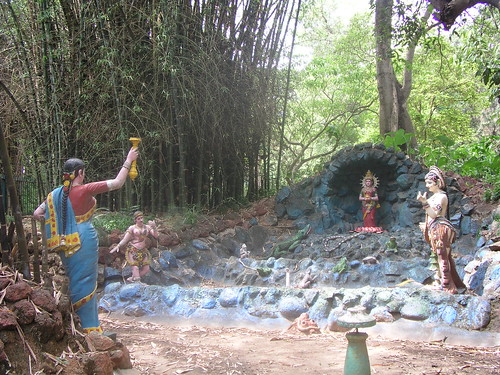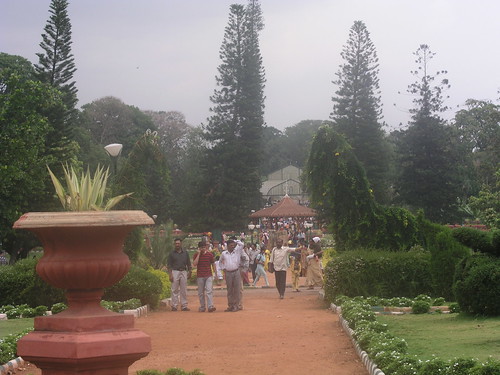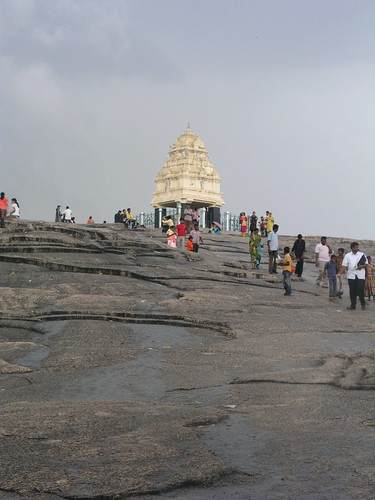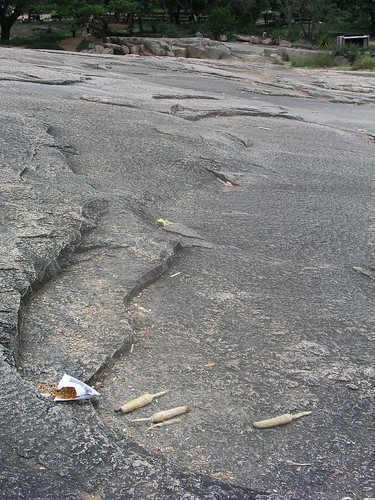
I was going to continue to write about public parks but that can wait. It's time to talk a little about food. Bangalore has turned out to be like Chicago, a great cosmopolitan melting pot of world cusines at affordabale prices in homey atmospheres. Too bad the demands and lunchtime buffets of TW University have generally kept me off the street at suppertime.
You can get good versions of just about anything here without ever going too far -- all of the Indian regions, Middle Eastern, Italian (especially if it's veggie-style), Mediterranean, Continental, American semi-fast (Chili's, Domino's, TGIF) and fast (MacDonald's, KFC), Chinese, Korean (doesn't a place called Barbecue Nation totally tempt you?) Thai, French bistro. Recently, a Bulgarian resturant opened at a downtown hotel which caused a lot of interest in the newspaper dining columns.
Once upon a time, I swore I would never waste blogspace on cooking tips, but right now, I just cooked one of my favorite Bangalore home meals and it might be useful for forangi (westerners) to know about this if they are into meat and find they don't have time to get to these places, either.
During the day, at the ThoughtWorks office and at the hotel where we conduct Thoughtworks University, there are buffet meals with a lot of carbo opportunities -- rice, bread, beans/peas/lentils, potatoes, cookies, crackers, ice cream, sweet desserts. Thanks to this, I now know why the local dress features so many baggy items -- it's not about the heat, it's the food -- it gets really hard to eat all of this stuff and stay comfortable in your trousers.
But for dinner at home, I discovered a brand of frozen ground lamb kabobs (aka kifta kabob) that is really pretty good. I can get a tiny cabbage, about the size of a grapefruit, from the cart down the street. The little market in the Diamond District parking garage always has shallots, garlic or onion; tomatoes, and peppers - red or green. Frozen peas are easy to find too. So I slice the sausage and the vegetables and saute them all in butter and olive oil.
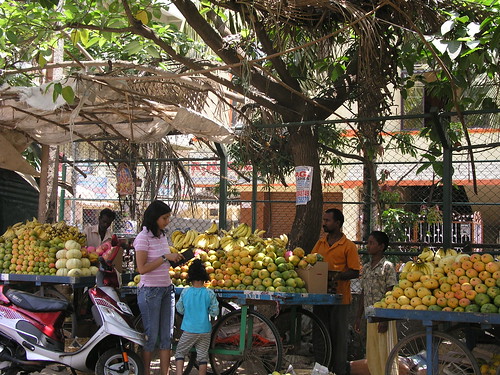
Then there's this great dairy product called Set Curd, which sounds awful to Americans, but is really like a cross between labna* and sour cream. Put that on the sausage-cabbage mix and serve with red wine. It makes me happy to eat it.
I found a local (means Karnataka State) wine that pairs very well with this dish. It's very much like the dry, dark red Greek wines Paul and I like, or old-time Zinfandel. The winery is Kinvah and the wine is a blend called Manthan. The label does not name the grapes. It needs to pair with food but that's OK as it makes a good house wine. It goes for about 450 Rs a bottle which is about $9 US here.
The set curd stuff is so good, it makes a great version of lamb stroganoff tossed with hot noodles or pasta and sauteed mushrooms and shallots. You can always add peas, too ...very Indian to add peas, it seems.
Set curd is also a great replacement for milk or cream in scrambled eggs. I have yet to try the lamb sausage in an omelet but my taste buds tell me it should go very well that way if fried up with shallots, red peppers and basil. If it's brunch or later, I'd do a white wine with this -- especially Chenin Blanc or a sparkling wine and a fruit salad. Since Chenin Blanc and Sauvignon Blanc grapes are doing OK in India, you can generally buy these wines at good prices without encountering too many disasters.

Yes, India has a wine industry. Most of the vineyards are in Maharashtra State, which borders the Arabian Sea and includes the cities of Mumbai and Pune. Only a few vineyards are in Karnataka State, the home of Bangalore. Karnataka is generally high desert so you could expect different wines to do well here, or at least, the same grapes will perform differently.
Of the Maharashtra vineyards, Sula is a consistent performer. They were a wine pioneer so have had more time to mature their vines and perfect their techniques. Their Sauvignon Blanc, when freshly released, is an excellent choice. Just opening a bottle and inhaling the bouquet excites my gourmet radar. It is more expensive though; a half bottle generally runs in that same 400 RS range ($8-9 US).
Since Indian food can be heavy, starchy, and spicy, Sauvignon Blanc is an good match and Chenin Blanc often provides just the right sweetness and bite to pair with tropical fruits and fried breads.
Karnataka is still searching for its wine identity. There are only about 9 wineries here. If anybody asked me, I would look to do here what has been done in Spain and certain parts of Italy and the Rhone. Nobody is growing southern Rhone grapes here that I've seen but a lot of effort is going into Shiraz, perhaps because of the proximity to Australia. I think Zinfandel is a better bet. This is high desert so many places get hot, but not too hot for good Zin, and there is a very interesting minerally red sand soil here (different from US Georgia clay) that can impart a lot of "terroir" (flavor of the land).
My favorite Karnataka winery so far is Grover Vineyards. Their La Reserva is a good attempt to reproduce an afforadable but accurate Bordeaux-style of wine (Cabernet-Merlot blend that matches with steaks). To that end, they've engaged a well-known consultant from France. Their rosé is an excellent buy if you like a dry, southern-France style rosé to pair with all of the spicy chicken and potato dishes available here.
Many restaurants in Bangalore serve Maya wines as their house wine. Maya is a Maharashtra winery and generally I have not been impressed. These wines usually have a plonky, skunky note. The Sauvignon Blanc is their best entry.
Some TW friends recently had a Big Banyan Cabernet at B-Flat, a wonderful jazz and supper club on 100 Ft. Road (try the "hot dog" a martini-style cockail of scotch, sweet vermouth and ginger liqueur). My friends report the wine was very surprising and chocolatey. Since they are ThoughtWorkers from Australia, I trust they have a good wine sense. I haven't had any Big Banyan wines yet but am looking for an opportunity. This is another Karnataka winery but they have an Italian instead of a French expert onboard.
If this post has caught your interest, there is a regular periodical published for the India consumer called Sommelier India.
* Labna is a very thick plain yogurt that has been strained of liquid so much, it is really a spreadable cheese.
